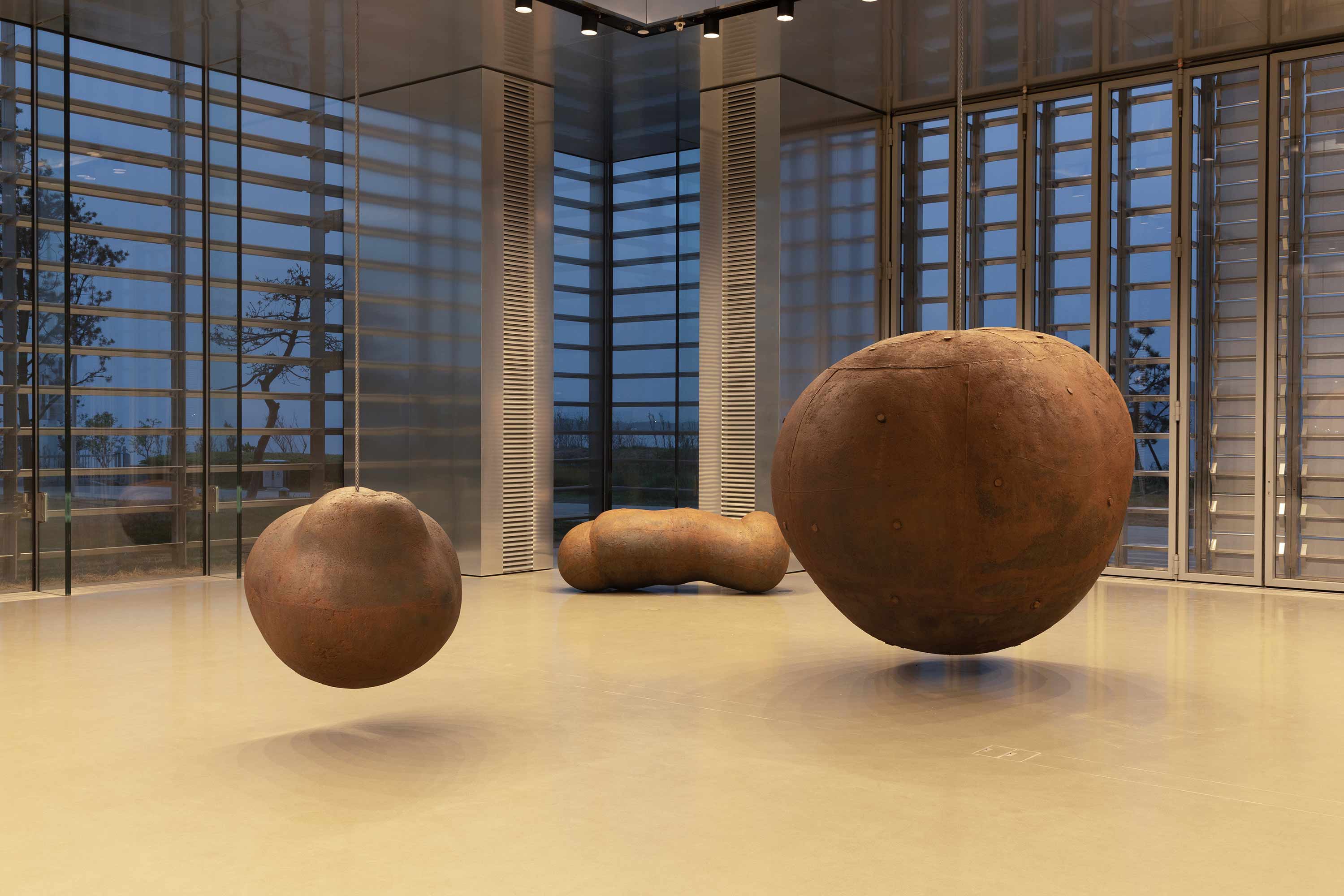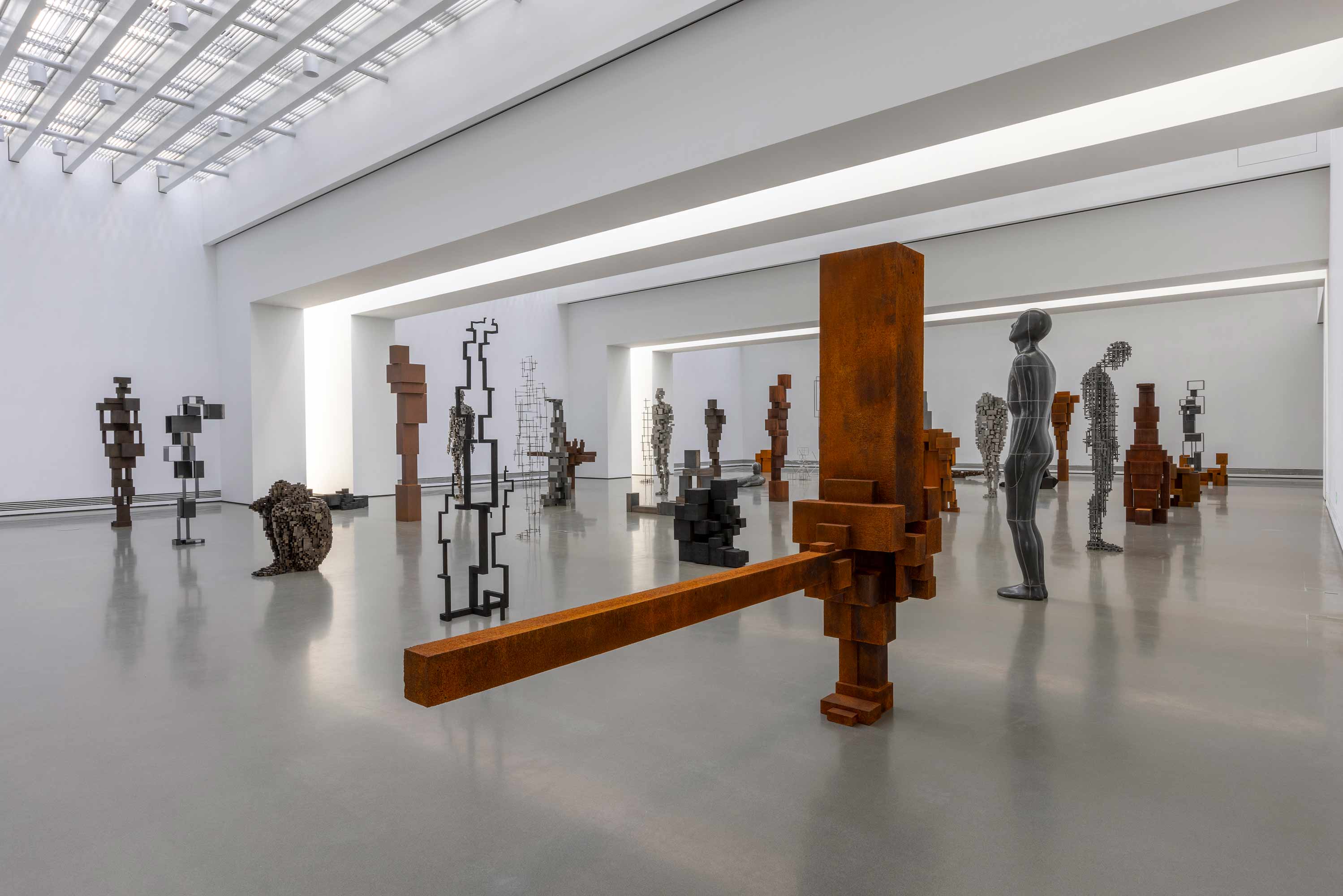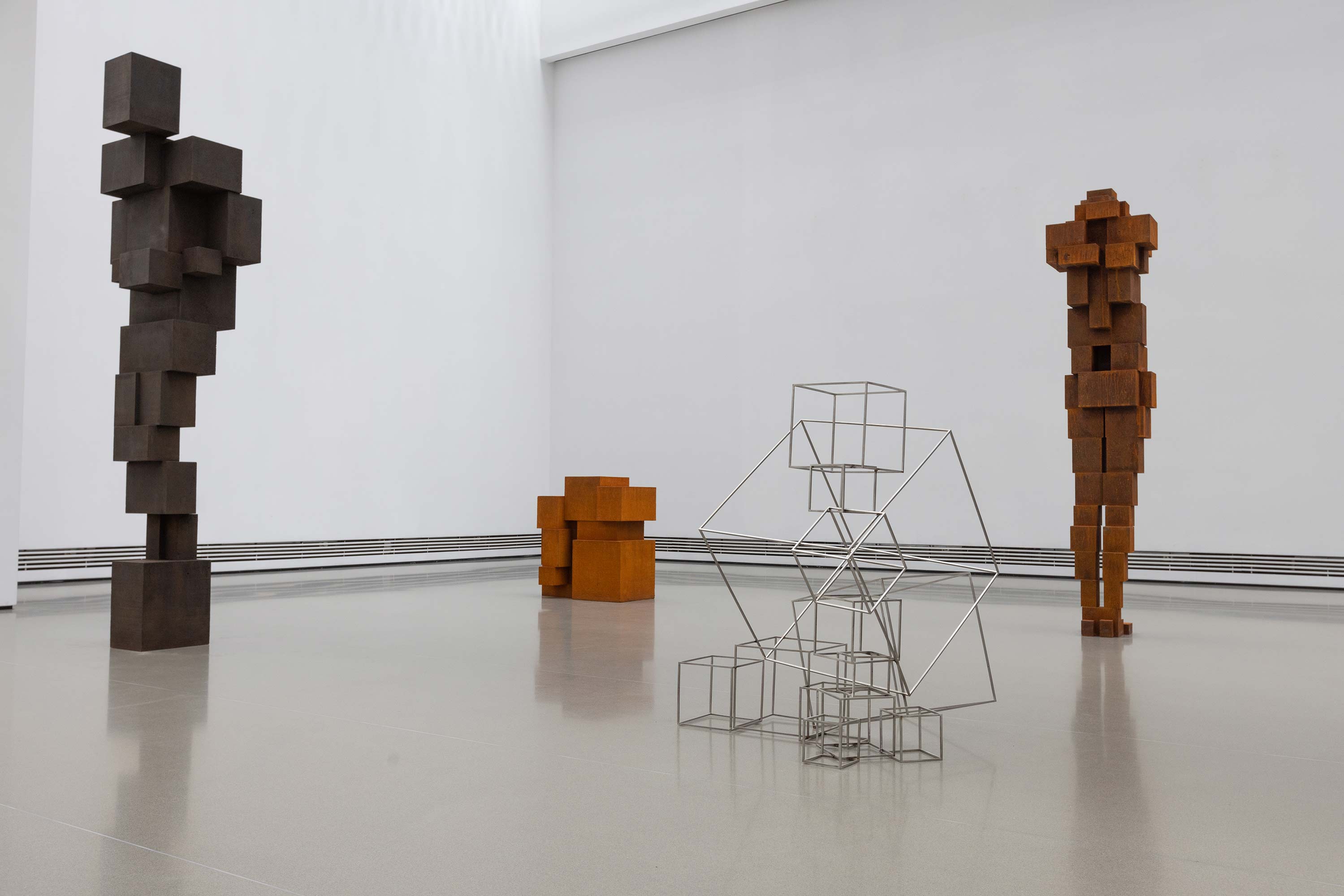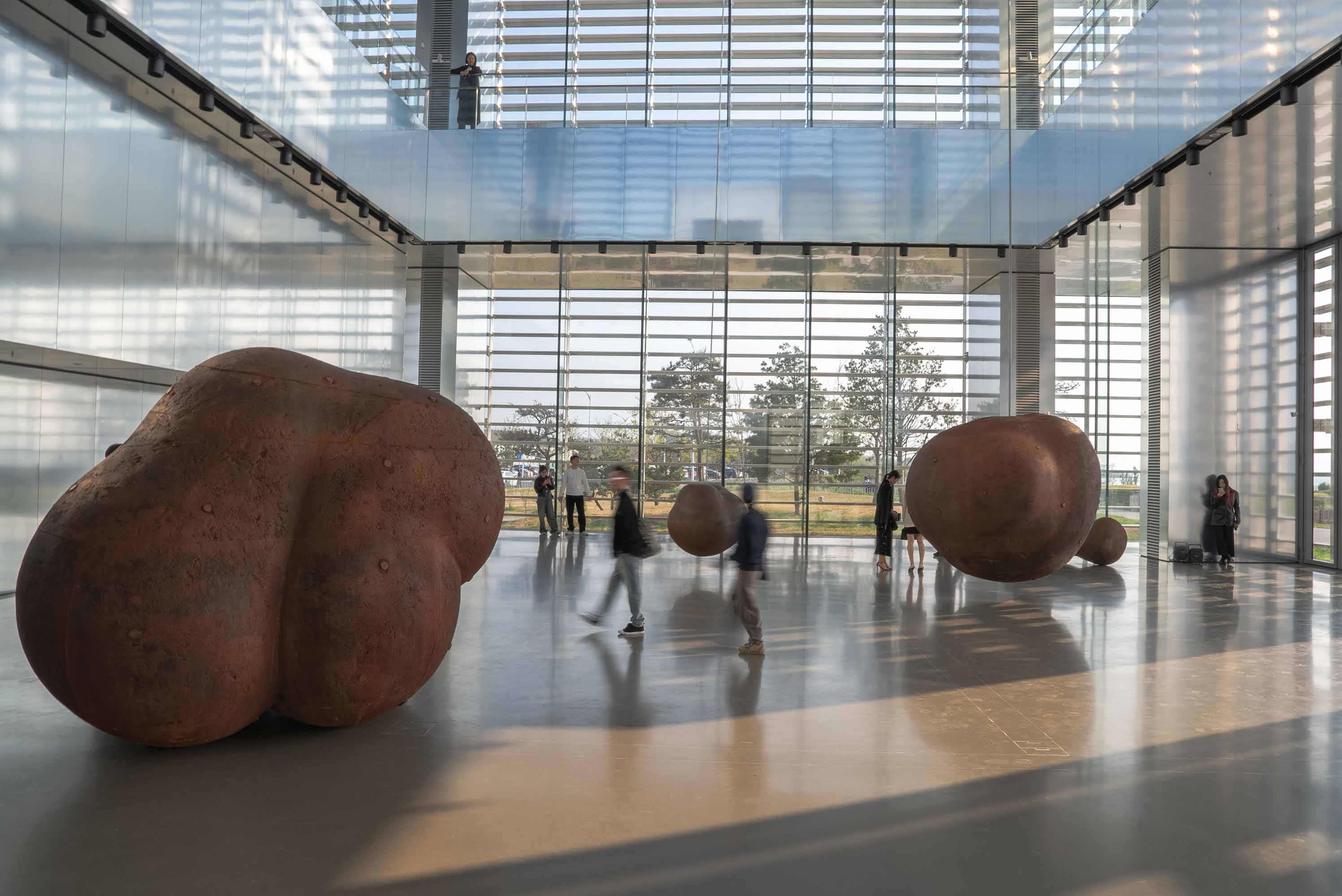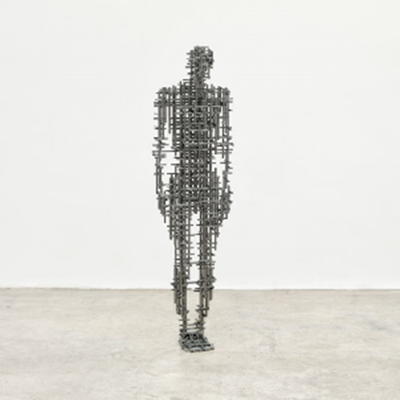As one of the most celebrated artists of our time, Antony Gormley is widely acclaimed for his sculptures, installations and public artworks that investigate the relationship of the human body to space. His work confronts fundamental questions of where human beings stand in relation to nature and the cosmos. Gormley continually tries to identify the space of art as a place of becoming in which new behaviours, thoughts and feelings can arise. Gormley’s work has been widely exhibited throughout the United Kingdom and internationally, and he has received numerous awards throughout his career, including the Turner Prize in 1994.
Living Time activates two of the museum’s spaces, Hall 4 and Hall 5. In Hall 4, 35 sculptures are displayed in a grid formation, in response to the enclosed space. This presentation shows a diverse array of the artist’s work, from the early lead works Plateau (1985–86) and Diaphragm (1995), their surfaces divided into horizontal and vertical axes, to significant sculptures in steel and iron that use the same axes to map the interior space of the body. Key works include Concentrate I (2003), which marks Gormley’s first attempt to transform the ‘pixel’ into a physical mass, Mean III (2016), which translates the body’s interior into a greatly reduced steel grid, and Tuck II (2018), which sees the human body become a precarious construction of slabs that reference megalithic structures.
The display in Hall 4 also marks the first occasion that Gormley has shown his work without reference to chronology, allowing visitors to form their connections between the works, each of which takes the artist's body as their subject and primary material.
The exhibition culminates in Hall 5 with four ‘Expansion Works’ that came out of an obsession with renegotiating the boundary of the skin. Body (1991/93), Fruit (1991/92), Earth (1991/93) and End Product (1990/93) are what Gormley has called ‘contained explosions’ that expand the skin’s surface by pushing outwards. In the process, they become less about the human body and more related to archaea, early cellular life forms or even fruits and vegetables. Earth and End Product accept gravity and have come to rest against the ground, whilst Body and Fruit are in suspended fall and hover just above the floor, the verticality of their long steel cables animating the space.
Speaking on the exhibition and its urgent message, Gormley has said: "This show reflects on the way that we have become increasingly contextualised by the built environment. The old saying that we make a world but then the world makes us has never been truer. I’m trying to reconcile the cyber world with the biological world and this show is a materialisation of the tension between them."
Mr. Fan Di’an, the curator, commented, "As a world-renowned contemporary artist, the opening of Antony Gormley’s solo exhibition at TAG Art Museum offers a rare opportunity for us to understand his unique artistic concepts and visually appealing artistic language. The exhibition, Living Time, reveals the artist’s inquiry into the subjects of body and space, life and world, human and nature, material and intelligence, showing the potential and power of the activated and empowered ancient art form, sculpture. To promote artistic exchanges between China and the world, TAG Art Museum introduces Gormley’s art to China. His artworks constitute a space for wandering, dialogue, and even philosophical thinking or inspiration through the viewer’s gaze. This is the remarkable achievement of the communication between Chinese art and international art."
Mr. Meng Xianwei, the founder of TAG Art Museum, expressed on the opening, "This exhibition marks the first solo exhibition of a Western artist at TAG Art Museum, and the ninth contemporary art exhibition since the opening of the museum. This significant exhibition will positively contribute to the museum's academic influence and the public's understanding of international contemporary art. Notably, the works presented in the 'Hanging Hall' embodied our initial vision for a globally unique exhibition style and an exceptional viewing experience for the audience. It epitomizes the harmonious symbiosis and mutual interaction between artworks and spatial environment, as well as the activation and communication of the energies of contemporary art and contemporary architecture.”
Mario Cristiani, president of Associazione Arte Continua, stated, ‘This is a great project that has the strength to overcome three years of challenges. After many years of preparation, we are now rewarded with the work that Antony Gormley has given us. Making this luminous space vibrate, they are a; gift made to the rebirth of a spirit of awareness generosity and openness to life; a message that through art unites people across the Pacific and an invitation to enjoy the most comprehensive presentation of Antony Gormley’s work in Asia to date. This bridging of cultures is an opportunity not to be missed. My thanks to Antony, his studio, the gallery staff, Mr. Meng Xianwei and his fantastic team, to the many visitors who will be able to enjoy these works and the collective work that has made it possible for them to be seen in such a beautiful way.
Living Time comes nearly 30 years after Gormley’s first trip to China. In 1995, the artist came to the region to conduct research for Asian Field (2003), his large-scale installation made in collaboration with the Chinese people. This trip took Gormley from Xi’an to the Forbidden City to Nanjing to Yangshuo County and then to brick factories in Zibo, Shandong Province. Speaking on its lasting impact on his life and work, Gormley has said: "I realised that China has a relationship with the pixel dating back 2000 years in treating the brick as a regular geometric unit that nevertheless relates to the embodied world. Going around China and seeing brick factories and the grey bricks of Nanjing’s city wall, for example, allowed me to see an extraordinary culture that is to do with formalising a relationship with the earth."
Accompanying the exhibition will be a richly illustrated catalogue. The book will feature extensive installation photography and essays by the curator Fan Di'an, producer Meng Xianwei, and scholar Yang Beichen, as well as a conversation between Antony Gormley and Hans Ulrich Obrist that will situate the exhibition within Gormley's wider practice and his long history of engagement with China.
Read more +
Read less -







 Sign in with email
Sign in with email




